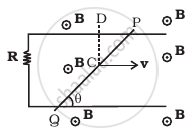Advertisements
Advertisements
प्रश्न
A rectangular loop of wire ABCD is kept close to an infinitely long wire carrying a current I(t) = Io (1 – t/T) for 0 ≤ t ≤ T and I(0) = 0 for t > T (Figure). Find the total charge passing through a given point in the loop, in time T. The resistance of the loop is R.

उत्तर
To find the charge that passes through the circuit first we have to find the relation between instantaneous current and instantaneous magnetic flux linked with it. The emf induced can be obtained by differentiating the expression of magnetic flux linked w.r.t. t and then applying Ohm’s law, we get
`I = E/R = 1/R (dphi)/(dt)`
According to the problem electric current is given as a function of time.
`I(t) = (dQ)/(dt)` or `(dQ)/(dt) = 1/R (dphi)/(dt)`
Integrating the variable separately in the form of differential equation for finding the charge Q that passed in time t, we have
`Q(t_1) - Q(t_2) = 1/R[phi(t_1) - phi(t_2)]`
For magnetic flux in rectangle:
Magnetic flux due to current carrying conductor at a distance x'
`Q(t) = (mu_0I(t))/(2pix^')`
If length of strip is L1 so total flux on strip of length L1 at distance x' is
`Q(t) = (mu_0I(t))/(2pix^') L_1`
X' varies from x to (x + L2) so total flux in strip
`phi(t) = mu_0/(2pi) L_1 int_x^(x + L_2) (dx)/x^' I(t) = (mu_0L_1)/(2pi) I(t_1) log_e ((L_2 + x))/x`
The magnetic of charge is given on length L1
`int_Q_1 dQ = 1/R int dphi` from (III)
`int_0^Q dQ = 1/R * (mu_0L_1)/(2pi) log_e ((L_2 + x)/x) int_0^1 I(t_1)`
`Q = (mu_0L_1)/(R2pi) log_e ((L_2 + x)/x)(I - 0) = (mu_0L_1I_1)/(2piR) log ((L_2 + x)/x)`
APPEARS IN
संबंधित प्रश्न
A conducting disc of radius r rotates with a small but constant angular velocity ω about its axis. A uniform magnetic field B exists parallel to the axis of rotation. Find the motional emf between the centre and the periphery of the disc.
A metal disc of radius 30 cm spins at 20 revolution per second about its transverse symmetry axis in a uniform magnetic field of 0.20 T. The field is parallel to the axis of rotation. Calculate
(a) the area swept out per second by the radius of the disc
(b) the flux cut per second by a radius of the disc
(c) the induced emf between the axle and rim of the disc.
Mechanical force per unit area of a charged conductor is ______
A wire of length 50 cm moves with a velocity of 300 m/min, perpendicular to a magnetic field. If the e.m.f. induced in the wire is 2 V, the magnitude of the field in tesla is ______.
A circular coil expands radially in a region of magnetic field and no electromotive force is produced in the coil. This can be because ______.
- the magnetic field is constant.
- the magnetic field is in the same plane as the circular coil and it may or may not vary.
- the magnetic field has a perpendicular (to the plane of the coil) component whose magnitude is decreasing suitably.
- there is a constant magnetic field in the perpendicular (to the plane of the coil) direction.
Find the current in the wire for the configuration shown in figure. Wire PQ has negligible resistance. B, the magnetic field is coming out of the paper. θ is a fixed angle made by PQ travelling smoothly over two conducting parallel wires separated by a distance d.

A rod of mass m and resistance R slides smoothly over two parallel perfectly conducting wires kept sloping at an angle θ with respect to the horizontal (Figure). The circuit is closed through a perfect conductor at the top. There is a constant magnetic field B along the vertical direction. If the rod is initially at rest, find the velocity of the rod as a function of time.

Find the current in the sliding rod AB (resistance = R) for the arrangement shown in figure. B is constant and is out of the paper. Parallel wires have no resistance. v is constant. Switch S is closed at time t = 0.

A magnetic flux associated with a coil changes by 0.04 Wb in 0.2 second. The induced emf with coil is ______.
